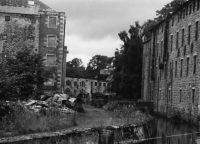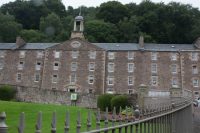New Lanark: the ‘great experiment’
I visited New Lanark, social reformer Robert Owen’s experimental village on the banks of the upper Clyde in the summer. It is almost forty years since I was last there.  The magic of the place hasn’t changed but the ‘visitor experience’ certainly has. New Lanark now gets almost half a million visitors a year – it was designated a World Heritage Site in 2001 and it should certainly be on the itinerary of anyone interested in the historical antecedents of the co-operative movement, our education system, or the Garden Cities and new towns movements.
The magic of the place hasn’t changed but the ‘visitor experience’ certainly has. New Lanark now gets almost half a million visitors a year – it was designated a World Heritage Site in 2001 and it should certainly be on the itinerary of anyone interested in the historical antecedents of the co-operative movement, our education system, or the Garden Cities and new towns movements.
New Lanark’s economic base was cotton spinning which was carried out there for almost two centuries until 1968. Founded by Robert Dale in 1785 he had high hopes it would come to rival Manchester. It never managed that, but its place in social history is assured, mainly because a successful young businessman from Manchester who visited the mills in the 1790’s married his eldest daughter Caroline and bought the mills off her father in 1799 assuming full control on 1 January 1800. That young man was Robert Owen, nowadays variously described as founder of British Socialism, spiritual founder of the Co-operative movement and revered worldwide as an educationalist, social reformer and visionary. New Lanark is his visible legacy. Owen ran a highly profitable business at New Lanark. The waters of the Clyde provided the power to run the cotton mills and in its heyday almost 2,500 people lived in New Lanark. But Owen had other ideas, ones which didn’t appeal to his business partners and there were several change of ownership and attempts to get rid of Owen as General Manager and as a partner. Owen was canny enough and wealthy enough, to see them off. Over the years he went on to build on Robert Dale’s enlightened working conditions for children – in 1793 of the 1,157 people employed spinning in the mills, almost 800 were children, of whom 450 were not even in their teens, extending this to living conditions, education, recreation and even shopping. Because New Lanark was a couple of miles from the old established town of Lanark, it was essentially a ‘new build’ model village with the mills, accommodation and other facilities all being built together to a plan. This included dormitories for children recruited from the orphanages of Glasgow and Edinburgh, family accommodation, and from 1816 a nursery, a school for children from 18 months to 12 years and in the same building, the rather grandiloquently named Institution for the Formation of Character evening classes for the teenagers working in the mills by day, and their parents. This of course also enabled women as well as men to work in the mills, as children under twelve no longer did so. As well a reading writing and arithmetic, singing, dancing, music and the appreciation of nature were all part of the curriculum indeed many lesson took place out of doors and when the weather did not permit this the teachers were encouraged to bring natural objects, flowers, interesting stones, even animals into the classroom. By 1816 the school had 274 pupils and fourteen teachers a teacher-pupil ratio that would be considered very good even by modern standards.
All this was Owen’s attempt to put into practice his ideas set out in his book ‘A New View of Society’ published in 1814. It was followed up, as Owen was a tireless proponent of his ideas, by ‘Report to the County of Lanark’ published in 1820, which despite its title and unlike ‘New View…’, was not concerned with the direct application of the lessons of New Lanark, but rather was a more general call for the transformation of society in which ‘the producer will have a fair and fixed proportion of all the wealth he creates.’ This propagandising resulted in hundreds of visitors to New Lanark to see the ‘great experiment’ in practice from all over Britain and beyond, including France, Germany, Switzerland, Austria, Russia and America. Over the years it led to the creation of dozens of ‘Owenite’ communities, 16 in the USA alone, as disciples tried to put ‘Mr Owen’s Plan’ into practice in utopian socialist communities, with varying success. The most famous, and most spectacular failure, was Owen’s own project, ‘New Harmony’ in Indiana in 1824. It never really got off the ground and had closed by 1828. Owen lost a fortune, forcing him to sell his share of the partnership in New Lanark.
Despite his severing of his connection with New Lanark, it continued to thrive – it was a very profitable business and its new owners could see the advantages of a healthy and contented workforce. Owen himself on his return from America in 1829 (all four of his sons remained there and became leading lights in American public life in the 19C) threw himself into a new role as leader of the working class movement something that would have been impossible in his previous incarnation as a rich mill owner. His writings had inspired the nascent co-operative movement and provided the trade unions with a political philosophy of their own for the first time, efforts which culminated in the formation of the Grand National Consolidated Trades Union in 1834. As with his educational and factory reform ideas, it was an idea ahead of its time, and the hostility of both Government and employers led to its collapse within the year, and amongst other things the transportation of the ‘Tolpuddle martyrs’. Although he lived on for almost a further 25 years, it was the end of his of his role as an influential force in public life.
Throughout the 19C while New Lanark gradually slid into obscurity, forgotten by the outside world, it retained many of its innovative features as its owners and managers were from Quaker backgrounds and many of then the descendants of people who had worked with Owen. Free electric lighting was provided to all the tenant in 1898, and the village store turned over to the Lanark Provident Co-operative Society in 1933. The village itself remained a model for what Owen had envisaged as the first of a series of similar communities; ‘that will be found capable of combining within themselves all the advantages that city and country residence now afford, without any of the numerous inconveniences and evils which necessarily attach to both of these modes of society.’ A sentiment that echo’s Ebenezer Howard’s vision for Garden Cities 75 years later.
Industrial change, finally led to the closure of the mills in 1968 and the village, with by then a population of barely 100, fell into decline as the owners struggled to find a buyer for an industrial site in a remote rural area. But, although several buildings were either partially demolished for safety reasons or partially collapsed, by 1973 a New Lanark Conservation Trust was formed, all the buildings were listed, the village declared an Outstanding Conservation Area and an action plan adopted. Vision, hard work, assistance from government both local and national, the persistence of the Trust and especially its manager Jim Arnold, have led to a remarkable renaissance. Forty years ago I remember as well as the beauty of the setting and the grandeur and romance of the buildings, a sense of desolation. Mill no 1 was largely in ruins and operating as a scrap metal recovery site.  Now it is the hotel, with conference, wedding and function facilities, swimming pool, gym and stunning views over the Clyde. The other buildings have been refurbished as a series of museums, a visitors centre, youth hostel, arts spaces, spaces for small businesses and private and social housing. A sense of slightly incredulous fun prevails; the hotel promotes itself as ‘Opened for business 1785; opened for pleasure 1998’. As an example of community-led regeneration alone, New Lanark is well worth the visit. With all that history it is an inspiration.
Now it is the hotel, with conference, wedding and function facilities, swimming pool, gym and stunning views over the Clyde. The other buildings have been refurbished as a series of museums, a visitors centre, youth hostel, arts spaces, spaces for small businesses and private and social housing. A sense of slightly incredulous fun prevails; the hotel promotes itself as ‘Opened for business 1785; opened for pleasure 1998’. As an example of community-led regeneration alone, New Lanark is well worth the visit. With all that history it is an inspiration.
This article first appeared in the September 2016 issue of Town and Country Planning

